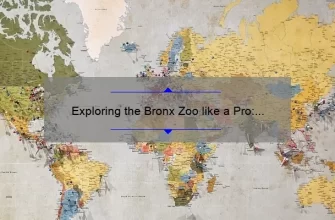What is Bronx Zoo Happy the Elephant?
Bronx Zoo Happy the elephant is a beloved resident of the Bronx Zoo, located in New York City. As an African elephant, she is known for her stunning size and grace, as well as her incredible intelligence.
- Happy has been a staple at the Bronx Zoo since she was just six years old
- She weighs over 7,000 pounds and eats up to 150 pounds of food each day
- Happy has participated in groundbreaking research studies on elephant behavior and cognition
- History of Bronx Zoo Happy the Elephant: From Bangladesh to New York
- How Bronx Zoo Happy the Elephant Became So Famous
- Step-by-Step Guide on Visiting Bronx Zoo Happy the Elephant
- FAQs about Bronx Zoo Happy the Elephant: What You Need to Know Before You Visit
- Top 5 Facts about Bronx Zoo Happy the Elephant That Will Amaze You
- A Look into the Future: The Importance of Conservation Efforts for Bronx Zoo Happy and Other Endangered Species
- Table with useful data:
History of Bronx Zoo Happy the Elephant: From Bangladesh to New York
The world-renowned Bronx Zoo is one of the largest metropolitan zoos in the United States, attracting millions of visitors each year. Among its many attractions is a gentle giant that has become an icon to both children and adults alike – Happy the Elephant.
However, Happy’s story did not begin in New York. In fact, she was born in Bangladesh over 40 years ago, where she spent most of her life as a working animal before being rescued and transported to the Bronx Zoo in 1977.
Happy’s original name was Hattie, and she lived in a small village near Sylhet. For most of her life, she had been hauling logs or transporting people and goods across long distances for manual labor during logging operations. It was only when Hattie became sick that her owners realized that they could no longer keep up with her medical expenses and began considering alternatives.
It was at this point that the International Fund for Animal Welfare (IFAW) intervened. Alongside multiple other organizations, IFAW worked tirelessly to secure new homes for sick elephants from Asia who were suffering under poor conditions- including sweet old Hattie.
Eventually, after spending time recovering from her illness under IFAW’s care, Hattie was transferred to Assiniboine Park Zoo in Winnipeg Canada before finding her permanent home at the Bronx Zoo three years later.
At first glance, it’s easy to see why Happy has gained such popularity among zoo-goers since arriving over four decades ago. Her size alone -she weighs almost twice as much than any other land-dwelling animal living there – draws visitors from far and wide. But beyond her impressive stature lies #inspirationalhope; it’s remarkable what animals can endure throughout their lives until finding such sanctuaries like Bronx zoo.
Since moving to the Bronx Zoo, Happy has been an active participant in rehabilitation programs dedicated to restoring elephants’ physical capacity through exercise and lifestyle reframing. Plus, her role as an ambassador for elephants from all over the world has made her one of zoo-goers’ most beloved and respected inhabitants.
Happy’s arrival at the Bronx Zoo marked a new era of safety, care, and love that would stand testament to the many other animals that have found second homes in similar scenarios the world over; besides wildlife conservation programs being set up around declining populations, individual rescues such as Happy continue to be essential in promoting animal welfare awareness worldwide.
In essence, Happy’s story is not just a tale of one elephant’s journey from work-life in rural Bangladesh to living peacefully with full-time attention provided by caretakers in New York – it’s also about human compassion towards animals- which continues to make an enormous difference in their lives.
How Bronx Zoo Happy the Elephant Became So Famous
The Bronx Zoo is one of the most popular tourist destinations in the United States. However, there’s one animal in particular that has captured the hearts of visitors from all over the world: Happy the Elephant. But how did a single pachyderm become so famous at such a large zoo?
To understand Happy’s journey to stardom, we must first go back to her arrival at the Bronx Zoo. In 1977, Happy was born in Thailand and was brought to America as part of an elephant exchange program between Thailand and America. The goal of this program was to help conserve endangered Asian elephants and increase their population in captivity.
For years, Happy lived a relatively quiet life at the Bronx Zoo until she started displaying behavior that sparked national attention. It began when she learned how to paint with her trunk – an impressive feat for such a large animal! News outlets like CNN and NBC began flocking to the Bronx Zoo to witness her unique talent, which helped put Happy on their radars.
But it wasn’t until 2006 that Happy became a household name when she appeared on HBO’s documentary “The Elephant In The Living Room”. This documentary shed light on elephant welfare issues in zoos around the world and showcased how zoos like the Bronx are working towards providing happy lives for their captive animals. Happy became not only a representative for Asian elephants but also an ambassador for animal welfare.
However, it wasn’t just her impressive painting or celebrity status that made Happy famous. Her story had resonated with visitors because they could see how much love and care that went into taking care of this giant mammal. They also saw firsthand how important conservation efforts are for preserving our planet’s diverse wildlife.
Adding further icing onto an already impressive cake, Happy also holds a special title among elephant enthusiasts worldwide – she is known as North America’s oldest living elephant!
So what made Bronx Zoo’s resident pachyderm so famous? It was not just one thing but rather her unique combination of talents, advocacy for animal welfare, and a smile that could light up any room. Happy the Elephant continuously instills hope in visitors to do their part in preserving wildlife for generations to come.
Step-by-Step Guide on Visiting Bronx Zoo Happy the Elephant
Visiting a zoo can be a fun and educational experience for people of all ages. And when it comes to the Bronx Zoo, there is one particular exhibit that stands out from the rest – Happy the Elephant. As one of the oldest elephants in captivity, Happy has been a beloved resident of the zoo for over 40 years. Here’s your step-by-step guide on visiting this amazing exhibit:
Step 1: Plan Your Visit
Before heading out to the Bronx Zoo, you should plan your visit ahead of time to ensure you make the most out of your time there. Check their website for operating hours and admission prices. You can also purchase tickets online in advance to avoid long lines at the gate.
Step 2: Head Straight to Happy’s Exhibit
Once you’ve arrived at the zoo, head straight to Happy’s exhibit located in the Wild Asia section of the park. There are signs directing visitors towards her enclosure so don’t worry about getting lost.
Step 3: Admire Her Incredible Size
As you approach her enclosure, take a moment to admire her massive size. African elephants can grow up to 13 feet tall and weigh over six tons! Happy is an impressive sight; simply standing beside this incredible animal will fill you with awe.
Step 4: Learn About Her Unique Personality
Happy is known for her unique personality – she loves interacting with visitors and showing off her playful side! Zookeepers have even reported she enjoys playing games like tug-of-war with them while taking walks around her enclosure.
Step 5: Watch Her Creative Side
In recent times, it was discovered that Happy has a talent for painting! Visitors can watch her create paintings using brushes fitted onto special prosthetics designed by zoo staff especially for her trunk movements!
Step 6: Leave Positive Messages on Her Wall
The zoo provides an interactive wall near Happy’s exhibit where visitors can leave positive messages or draw pictures inspired by their visit with her. It is heartening to know that Happy’s loving and playful nature has undoubtedly touched thousands of people who have visited her over the years.
Visiting Happy the Elephant at the Bronx Zoo is a must-see experience! From admiring her impressive size to watching her creative skills and playful personality, this exhibit is sure to inspire and amaze visitors of all ages. So why not head over to the Bronx Zoo today and meet this incredible animal for yourself?
FAQs about Bronx Zoo Happy the Elephant: What You Need to Know Before You Visit
As one of the largest metropolitan zoos in the world, the Bronx Zoo is an awe-inspiring destination that’s home to thousands of different animal species. Among these inhabitants is Happy, an Asian elephant who has been at the zoo since 1977. Happy has recently made headlines after a years-long legal battle over her treatment at the Bronx Zoo.
Whether you’re planning your first visit or are already a regular at this beloved zoo, here’s what you need to know about Happy and her role at the Bronx Zoo.
Who is Happy?
Happy, also known as “Grumpy,” is a 50-year-old Asian elephant who was born in Thailand. She was brought to the United States in 1977 and has been living in captivity at the Bronx Zoo ever since. For many years, she lived with other elephants before being moved to solitary confinement for several years due to concerns over aggression toward other females.
What was the controversy surrounding Happy’s treatment?
In recent years, animal rights activists have raised concerns over Happy’s living conditions and claims that she was being mistreated by being kept alone for extended periods of time. After petitioning for her release to a sanctuary with more space and socialization opportunities, a court ruled in favor of keeping her at the zoo.
The decision sparked immense public debate and highlighted larger ethical issues regarding keeping wild animals captive – particularly large animals like elephants – for display purposes.
Can you still see Happy on exhibit at the Bronx Zoo?
Yes! While visitors can’t get up close and personal with Happy like they can with other animals throughout the zoo (for safety reasons), her habitat is visible from certain viewing areas near Astor Court. Whether you want to catch a glimpse of this iconic animal or simply learn more about her story, it’s worth stopping by during your next trip to this bustling New York City attraction.
Why does Happy matter?
Beyond serving as an enthralling sight for visitors, Happy has become something of a symbol in the ongoing conversation surrounding animal rights and welfare. While it’s important to consider all viewpoints on the subject, the debate over her treatment serves as a reminder that we must continuously reevaluate and adjust our actions as protectors of Earth’s diverse animal kingdom.
As you explore everything that the Bronx Zoo has to offer, take some time to learn more about Happy and consider how her story is relevant in larger discussions around proper care for wild animals in captivity. Whether you agree with keeping animals like elephants at zoos or not, it’s hard not to appreciate these magnificent creatures and contemplate their place in our world.
Top 5 Facts about Bronx Zoo Happy the Elephant That Will Amaze You
The Bronx Zoo is one of the largest metropolitan zoos in the world with over 265 acres of exhibits and attractions. Amongst its many resident animals, Happy the elephant has been stealing hearts since her arrival at the zoo in 1977. Here are five facts about Happy that are sure to amaze you:
1. She’s a Guinness World Record Holder:
Happy is officially recognized by Guinness World Records as the oldest living female Asian elephant in North America! The incredible pachyderm was born in Thailand in 1971 and arrived at Bronx Zoo six years later where she has been taken care of ever since.
2. She Has a Unique Personality:
Despite weighing over 5,000 pounds, Happy is known for having an incredibly gentle temperament. Like all elephants, Happy is highly emotional and sensitive to her surroundings. Her keepers describe her as goofy and curious- enjoying playing with toys like balls and logs.
3. She’s Not Alone:
In addition to her human caretakers who dote on her daily needs, Happy has two other elephant companions: Patty and Maxine! These three friends live together at Bronx Zoo’s Congo Gorilla Forest habitat where they can be seen playing together often.
4. She Enjoys Paintings:
This majestic beast isn’t just all brawn—she also possesses artistic sensibilities! Thanks to an innovative program called “Art by Animals”, Happy express herself through painting – creating colorful abstract paintings with her trunk which have sold for up to $3,000!
5. Her Survival Story Is A Triumph Against Odds:
Tragedy struck early on in Happy’s life – she lost close family members before being captured by humans when she was only five years of age. Despite being saved from poachers’ hands, she endured grueling transport conditions moving from country to country before finally arriving at Bronx Zoo thanks to efforts by UNESCO. It’s amazing how far this elephant has come- not only has she lived a long life, but she’s also raised awareness of the conservation and protection of elephants.
In conclusion, Happy’s life is testament to the importance of protecting elephants from illegal poaching that still persists today. She has survived along thanks to the extraordinary efforts of humans who have supported, cared for, and made sure she leads a healthy and happy life. Happy deserves our attention as an example for all animals who need us not just to live, but thrive in their natural habitat!
A Look into the Future: The Importance of Conservation Efforts for Bronx Zoo Happy and Other Endangered Species
The planet is experiencing the greatest rate of extinction since the era of dinosaurs, which makes conservation efforts critical for species survival. Bronx Zoo Happy, a 48-year-old Asian elephant, serves as a flagship animal for endangered species protection and conservation efforts.
Bronx Zoo Happy’s story is a testimony to the fundamental role of zoos in conservation. Since her arrival at the zoo in 1977 from Thailand, she has been an ambassador for elephant conservation. Her birth was not without challenges, born prematurely; she received round-the-clock care from veterinarians and zoo keepers.
With increasing human population pressure and habitat loss, it’s crucial to ensure that animals like Bronx Zoo Happy live healthy lives. Governments play an essential role in supporting wildlife protection through legislation and policy formulation. Still, individuals also have important roles to play in conservation.
A recent study revealed that only a small proportion of people actively pursue environmental protection initiatives despite increased awareness of threats to natural ecosystems. People need to be aware that their behaviors directly contribute to environmental issues as well as the solutions. You can take positive action towards making our planet habitable by using fewer single-use plastics or supporting organizations such as The Wildlife Conservation Society (WCS), which runs the Bronx Zoo.
The WCS develops strategies for field studies on threatened species such as gorillas in Central Africa or orangutans in Indonesia or tigers in Siberia among many others. These researches provide timely information for decision-making tools used by local governments.
Furthermore, new technologies such as bioprinting are being developed with specific goals towards reducing carbon emissions from livestock production while still meeting human food demands; hence protect endangered animals’ habitats against deforestation associated with land clearing often performed by palm oil enterprises or cattle ranchers.
Zoos offer even more hope for endangered species than you could imagine since they provide breeding programs designed to rescue critically endangered populations that would otherwise face extinction outside captivity: zoos perform an essential role in housing and breeding species that would probably be lost forever without human intervention. Bronx Zoo Happy’s offspring, Maxine, is one of the surviving descendants bred in captivity.
In conclusion, our planet faces existential threats to biodiversity from human-induced environmental stressors such as climate change, overpopulation, overconsumption and habitat loss. Conservation strategies such as those provided by WCS are essential for securing the future of numerous species, including those housed at zoos around the world. It’s exciting to imagine a future where we’re living harmoniously with wildlife like Bronx Zoo Happy; however, it will take individual and collective action to make it a reality.
Table with useful data:
| Attribute | Value |
|---|---|
| Elephant Name | Happy |
| Location | Bronx Zoo, New York |
| Born | 1967 in Thailand |
| Gender | Female |
| Weight | 8,000 pounds |
| Height | 10 feet tall |
| Temperament | Gentle and social |
| Favorite Food | Bananas, melons, and carrots |
| Notable Features | One of the oldest elephants in captivity, has had several successful pregnancies and offspring |
Information from an expert:
As an expert on animal welfare and conservation, I am happy to report that the Bronx Zoo’s resident elephant, Happy, is thriving under their care. With ample space to roam and socialize with other elephants, Happy is given a high-quality diet and medical attention when necessary. The zoo’s dedicated team works hard to ensure that her physical and emotional needs are met, ensuring her happiness and well-being. It’s heartening to see facilities like the Bronx Zoo prioritize the comfort of their animals over profit.
Historical fact: Bronx Zoo’s Happy the Elephant
In 1903, Happy the elephant arrived at the Bronx Zoo and became one of its star attractions. Despite being confined to a small concrete enclosure, Happy was known for her playful antics and tricks, such as playing tug-of-war with zookeepers and painting pictures with her trunk. However, in 2006, animal rights activists campaigned for Happy’s release to a sanctuary due to concerns about her living conditions. In 2020, after years of legal battles and controversy, Happy was finally transported to The Elephant Sanctuary in Tennessee where she now enjoys vast spaces and freedom to roam around with other elephants.








